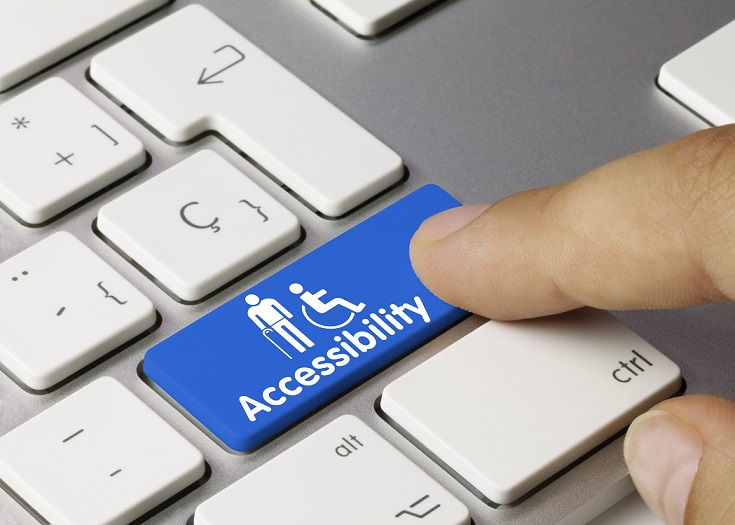 The Accessible Information Standard (AIS), known officially as SCCI1605 Accessible Information, is a new mandatory ‘information standard’ for implementation by all organisations that provide NHS or adult social care – including GP practices – that needs to be in place by 31 July 2016.
The Accessible Information Standard (AIS), known officially as SCCI1605 Accessible Information, is a new mandatory ‘information standard’ for implementation by all organisations that provide NHS or adult social care – including GP practices – that needs to be in place by 31 July 2016.
The Accessible Information Standard aims to ensure that people who have a disability or sensory loss receive information that they can access and understand (for example in large print, braille or via email) and professional communication support if they need it, such as from a British Sign Language interpreter.
As a result, the Standard requires GP practices to:
- Ask people if they have any information or communication needs, and find out how to meet their needs
- Record those needs clearly and in a set way
- Highlight or flag the person’s file or notes so it is clear that they have information or communication needs and how to meet those needs
- Share people’s information and communication needs with other providers of NHS and adult social care, when they have consent or permission to do so
- Take steps to ensure that people receive information which they can access and understand, and receive communication support if they need it
AIS and your practice
With the official bit out of the way, what does that really mean for you and your practice?
Officially, by the beginning of April this year, practices should have started identifying and recording information and communication needs with service users, either at the first interaction or registration with their service or as part of ongoing routine interaction with the service by existing service users. This should have been preceded in September 2015 by an assessment of current systems and processes and the development of a ‘local implementation plan’. Together, these pretty much form the Standards.
In reality, especially as very little help seems to have been provided by CCGs, many practices are yet to start looking at this – so what should you do? Here’s Practice Index’s 10-step guide, put together with the help of practice managers via the Practice Index Forum:
- Step one is to run a report that identifies all patients with accessibility issues. The Standard applies to patients and service users who have information or communication needs relating to a disability, impairment or sensory loss. It also applies to parents and carers of patients or service users who have such information or communication needs, where appropriate. Individuals most likely to be affected by the Standard include people who are blind or deaf, who have some hearing or visual loss, people who are deafblind and people with a learning disability. However, this list is not exhaustive.
- Brief staff about the Standard, preferably via a face-to-face session (particularly for those most directly involved in its implementation), and follow-up with email information about what it will entail. Could you appoint somebody to take this project on?
- Communicate with patients to find out what their communication preferences are. Some practices are sending letters to patients (an example has kindly been made available on the Practice Index Forum) while others are phoning patients and emailing – which can be read aloud to blind patients via a computer. It’s worth remembering that you’re contacting people with accessibility problems, so it might be worth utilising a mixture of communication tools. Don’t forget your website too!
- Put a notice up in the waiting room asking patients to tell us if they have any communication preferences. Again, consider who your audience is – do notices need to be in large print or on yellow paper?
- It’s worth thinking about technology. For example, review existing policy and practice around use of email and text message to communicate with patients; these can be quick, cheap and convenient ways of contacting lots of people who have hearing or visual loss. If there’s an induction loop system available (to support hearing aid users), check that it works and that staff know how to use it.
- The next stage suggested by practice managers is to Read Code patients’ medical records to show they have been contacted. One practice uses a preferred method of contact code XaQmO, for example.
- Next, it’s time to put a note on the front screen of patients records to highlight they have a communication need. On systmOne there is a box you can tick to show preferred contact method – Admin tab > Patient Details > Record Contact details > tick the box for Preferred Contact Method.
- Now it’s time to ensure the required documents are ready and waiting. It could be worth compiling a stock of braille, audio, easy read and alternative language documents, which can be accessed from the NHS free of charge. Practices should also be able to provide large print versions of practice policies and other information on yellow paper for visually impaired patients and PDF documents enabled to work with the read aloud function. www.easyhealth.org.uk is a handy resource to turn to. It’s obviously impractical to hold every leaflet in every language or in braille, so in most cases the offer of one should suffice – and keep CQC inspectors happy.
- Amending your registration or new patient forms so that they are more accessible and include a question or section about information and communication needs is a good idea – and a quick way to pick up communication preferences.
- Make sure you have an ongoing policy of checking patient communication needs – as health can deteriorate. Identification of current patient needs can be carried out opportunistically as they contact your practice. Much of this is down to practice staff to use their initiative in identifying people who could benefit from more questioning.
We hope this helpful but if you need more information, head along to the NHS England website. This includes the full suite of documents associated with the Standard. The Information Standards Notice (ISN), Specification and Implementation Guidance for the Standard are published on the Health and Social Care Information Centre website.
How are you implementing the new AIS? Let us know by commenting below or join the conversation on the Practice Index Forum here.
————–
Trending topics in the forum:
Do you feel in control? Does the ‘buck’ stop with you?
National minimum wage/Living wage causes discord in staff as pay gap decreases
Coming in to manage (what has proven to be) a difficult team!





June 13, 2016 at 7:23 am
We are constantly hearing of the overload of additional work to practices, with no additional resources, and the promise to cut unnecessary bureaucracy, however, this never materialises. We continue to be burdened with additional work such as this (I am not saying that this is not important) but it does add to the workload, on already sinking General Practice, with no additional resources with which to carry it out. It is becoming impossible to manage Practices routinely due to constantly firefighting. It is not sustainable and I for one will be looking to “jump ship” at the first opportunity that comes my way. Sorry but it is no longer healthy to work in the Health Service!! Irony at its worst!!